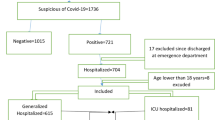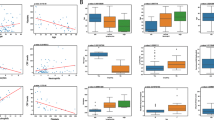Abstract
The new coronavirus (COVID-19) outbreak had a severe impact on the health of entire communities and the world economy. Despite the high COVID-19 survival rate, there are more severe instances that end in sadism every day. It is anticipated that early identification of COVID-19 at-risk patients and the implementation of preventative interventions will improve patient survival and lower fatality rates. The research involved analyzing 1,023,426 patient samples taken from the Kaggle repository of 60 features. The data were analyzed using classification algorithms, such as Decision Tree Classifier (DTC), Random Forest Classifier (RFC), Gaussian Navies Bayes (GNB), k-Nearest Neighbors (kNN), and Artificial Neural Network (ANN). Initially, the data were pre-processed using several pre-processing techniques. Additionally, the missing literals are filled using kNN Imputer and SMOTE, Nearmiss, and Resample are used to balance out the data. Experiments were performed using twenty-one features of comorbidity diseases along with drugs and fourteen features of comorbidity diseases are identified as significant for predicting the survival versus the deceased COVID-19 patients.The findings indicate that twenty-one features of the imbalanced precision results for k = 5 demonstrate DTC, RFC and GNB achieve a perfect 100% precision, while ANN achieves 94%. Notably, kNN attains a commendable precision of 86%.

























Similar content being viewed by others
Explore related subjects
Discover the latest articles, news and stories from top researchers in related subjects.Data Availability
The dataset produced and scrutinized in this study are accessible from the corresponding author upon reasonable request.
References
Aljameel A, Sumayh S, Irfan UK, Nida A, Malak A, Eman SA. Machine Learning-Based Model to Predict the Disease Severity and Outcome in COVID-19 Patients. Sci Program. 2021;1:5587188. https://doi.org/10.1155/2021/5587188.
Mishra M, Ganesh P, Debadash P. Molecular docking and ADMET study for searching multi-targeted antiviral compounds against SARS-CoV-2: A computational approach. Int J Appl Sci Eng. 2021;18(2):1–10. https://doi.org/10.6703/IJASE.202106.
Sarkar Uditendu, Banerjee Gouravmoy, Ghosh Indrajit. Artificial intelligence in agriculture: Application trend analysis using a statistical approach. Int J Appl Sci Eng. 2022;20(1):1–8. https://doi.org/10.6703/IJASE.20230320(1).002.
Gazzaruso Carmine, Paolozzi Enrico, CinziaValenti Mauro Brocchetta, Naldani Daniela, Grignani Claudio, FabrizioSalvucci Francesco Marino, Coppola Adriana, Gallotti Pietro. Association between antithrombin and mortality in patients with COVID-19. A possible link with obesity. Nutr, Metabol Cardiovascu Dis. 2020;30(11):1914–9. https://doi.org/10.1016/j.numecd.2020.07.040.
Albahri A, Ahmed S, Rula AH, Alwan Jwan K, Alqays ZT, Zaidan AA, Zaidan BB, Albahri AOS, et al. Role of biological data mining and machine learning techniques in detecting and diagnosing the novel coronavirus (COVID-19): a systematic review. J Med Syst. 2020;44:1–11. https://doi.org/10.1007/s10916-020-01582-x.
Anisha PR, Kishor Kumar Reddy C, Hanafiah MM, Murthy BR, Mohana RM, Pragathi YVSS. An intelligent deep feature based metabolism syndrome prediction system for sleep disorder diseases. Multimedia Tools Appl. 2023. https://doi.org/10.1007/s11042-023-17296-4.
Ahmed A, Sarah A, Carla TT, Mahmood A, Sara I, Abu Serhan H, Abd-Alrazaq Alaa A, Mowafa H. Machine learning models to detect anxiety and depression through social media: A scoping review. Comput Methods Prog Biomed Update. 2022;2:100066. https://doi.org/10.1016/j.cmpbup.2022.100066.
Lalmuanawma S, Jamal H, Lalrinfela C. Applications of machine learning and artificial intelligence for Covid-19 (SARS-CoV-2) pandemic: A review. Chaos, Sol Fractals. 2020;139:110059. https://doi.org/10.1016/j.chaos.2020.110059.
Pushpa CN, Thriveni J, Venugopal KR, Patnaik LM. Web Page Recommendation System using Self Organizing Map Technique. Int J Curr Eng Technol. 2014;4(5):3270–7.
Chowdhury EH, Muhammad EH, Tawsifur R, Amith K, Somaya A, Susu MZ, Suhail AR, Hanadi H, Mohammad TI. An early warning tool for predicting mortality risk of COVID-19 patients using machine learning. Cogn Comput. 2021. https://doi.org/10.1007/s12559-020-09812-7.
Suresh Kumar HS, Pushpa CN, Thriveni J, Venugopal KR. Comorbidities and COVID-19 Pandemic Dynamics: A Review. GIS Sci J. 2023;10(3):1852–76.
Wang Jiachi, Fan Yongqi, Li Hang, Yin Shoulin. WeChat mini program for wheat dis-eases recognition based on VGG16 convolutional neural network. Int J Appl Sci Eng. 2023;20(3):1–9. https://doi.org/10.6703/IJASE.20230920(3).008.
Nemati M, Jamal A, Nazafarin N. Machine-learning approaches in COVID-19 survival analysis and discharge-time likelihood prediction using clinical data. Patterns. 2020. https://doi.org/10.1016/j.patter.2020.100074.
Musatafa A, Abbood A, Sabrina T, Masri A, Fahad TA. Particle Swarm Optimization-Based Extreme Learning Machine for COVID-19 Detection. Cogn Comput. 2024;16:1858–73. https://doi.org/10.1007/s12559-022-10063-x.
Karagiannidis C, Krause F, Bentlage C, Wolff J, Bein T, Windisch W, Busse R. In-hospital mortality, comorbidities, and costs of one million mechan-ically ventilated patients in Germany: a nationwide observational study before, during, and afterthe COVID-19 pandemic. Lancet Reg Health. 2024;42:100954. https://doi.org/10.1016/j.lanepe.2024.100954.
Markovic R, Ternar L, Trstenjak T, Marhl M, Grubelnik V. Cardiovascular Comorbidities in COVID-19 Comprehensive Analysis of Key Topics. Interact J Med Res. 2024;13:e55699.
Ashmawy Rasha, Hammouda Esraa Abdellatif, Yousra AE, Iman A, Mai H, Vladimir NU, Elrashdy MR. Interplay between Comorbidities and Long COVID: Challenges and Multidisciplinary Approaches. Biomolecules. 2024. https://doi.org/10.3390/biom14070835.
Maria S, Haseeb K, Wajid M, Moona N, Abdulwahed FA, Mohammed FA, Anwar A, Malik B. Unravelling the complex interplay of age, comorbidities, and multimor-bidities in COVID-19 disease progression: Clinical implications and future perspectives. Heliyon. 2024;10(15):e35570. https://doi.org/10.1016/j.heliyon.2024.e35570.
Lodato I, Aditya VI, Isaac ZT, Zhong YL, Shukying H. Prognostic model of COVID-19 severity and survival among hospitalized patients using machine learning techniques. Diagnostics. 2022;12(11):2728. https://doi.org/10.3390/diagnostics12112728.
Suresh Kumar HS, Preethi N, Pushpa CN, Thriveni J, Venugopal KR. DeEffNet: A CNN Model for Optimizing the Image Classification of Comorbid Patients. ICMISC. 2023;873:741–50.
Lazzarini N, Filippoupolitis A, Manzione P, Eleftherohorinou H. A machine learning model on Real World Data for predicting progression to Acute Respiratory Distress Syn-drome (ARDS) among COVID-19 patients. PLoS One. 2022;17(7):1–16. https://doi.org/10.1371/journal.pone.0271227.
Asteris PG, Styliani K, Eleni G, Markos ZT, Panagiotis H, Maria P, Andreas K, et al. Early prediction of COVID-19 outcome using artificial intelligence techniques and only five laboratory indices. Clin Immunol. 2023;246:109218. https://doi.org/10.1016/j.clim.2022.109218.
Daniel MI, de Moura J, Marcos PJ, Rey EM, Novo J, Ortega M. Comprehensive analysis of clinical data for COVID-19 outcome estimation with machine learning models. Biomed Sign Process Control. 2023;84:104818. https://doi.org/10.1016/j.bspc.2023.104818.
Banujan K, Mohamed I, Kumara BTGS. Boosting ensemble machine learning approach for covid-19 death prediction. Sri Lanka J Soc Sci Human. 2023. https://doi.org/10.4038/sljssh.v3i1.88.
Ahmad M, Usama I, Yasar M, Waqas M. Lightweight ResGRU: a deep learning-based prediction of SARS-CoV-2 (COVID-19) and its sever-ity classification using multimodal chest radiography images. Neural Comput Appl. 2023;35(13):9637–55. https://doi.org/10.1007/s00521-023-08200-0.
Tulu TW, Tsz KW, Ching LC, Chun HW, Peter YMW, Cee ZST, Asmir V, Cristina M, Kei HKC. Machine learning-based prediction of COVID-19 mortality using immunological and metabolic biomarkers. BMC Digit Health. 2023;1(1):6. https://doi.org/10.1186/s44247-022-00001-0.
Zagrouba R, Muhammad AK, Muhammad A, Muhammad FM, Abdur R, Muhammad FK. Modelling and Simulation of COVID-19 Outbreak Prediction Using Supervised Machine Learning. Comput Mater Continua. 2021;66(3):237. https://doi.org/10.32604/cmc.2021.014042.
Hadiyoso S, Suci A, Indrarini D. Diagnosis of lung and colon cancer based on clinical pathology images using convolutional neural network and CLAHE frame-work. Int J Appl Sci Eng. 2023;20(1):1–7.
Ghorui A, Subhasri C, Roshan M, Arulmozhivarman P, Balamurugan S. Deployment of CNN on colour fundus images for the automatic detection of glau-coma. Int J Appl Sci Eng. 2023;20(1):1–9.
Pushpa CN, Gerard D, Mohammed Z, Venugopal KR. EnhancedNeighborhood Nor-malized Pointwise Mutual Information Algorithm for Constraint Aware Data Clustering. ICTACT J Soft Comput. 2016. https://doi.org/10.21917/ijsc.2016.0176.
Suresh Kumar HS, Bhoomika S, Pushpa CN, Thriveni J, Venugopal KR. MobNetCov19: Detection of COVID-19 Using MobileNetV2 Architecture for Multi-mode Images. ICCSST. 2023;1973:452–63. https://doi.org/10.1007/978-3-031-50993-336.
Hasan D, Atara M, Ardhi W, Dewi W, Haryono S. Fast Na¨ıve Bayes classifiers for COVID-19 news in social networks. Indonesian J Electr Eng Comput Sci. 2024;34(2):1033–41. https://doi.org/10.11591/ijeecs.v34.i2.pp1033-1041.
Reddy R, Kumar UMA. Classification of user’s review using modified logistic regression technique. Int J Syst Assur Eng Manag. 2024;15:279–86.
R. Reddy and G. K. Shyam, "Analysis Through Machine Learning Techniques: A Survey”, Second International Conference on Green Computing and Internet of Things (ICGCIoT), IEEE, pp. 542-546,2018.
Arakeri M, Lakshmana RR, et al. An Enhanced Approach to Intelligent Computer-Assisted Localization of Liver Tumor on Computed Tomography Images. SN Comput Sci. 2024;5:809.
Manukumaar OG, Reddy R, Metipatil P. Efficient Melanoma Disease Detection by Using Convolutional Neural Network. Springer: Lecture Notes on Algorithms for Intelligent Systems; 2024. p. 437–48.
Acknowledgement
The authors acknowledged the University of Visvesvaraya College of Engineering (UVCE), Bengaluru, Karnataka, India and Bangalore University, Bengaluru, Karnataka, India for supporting the research work by providing the facilities.
Funding
No funding received for this research.
Author information
Authors and Affiliations
Contributions
This research was a collective effort, made possible through the collaboration and contributions of all authors involved.
Corresponding author
Ethics declarations
Conflict of interest
No conflict of interest.
Additional information
Publisher's Note
Springer Nature remains neutral with regard to jurisdictional claims in published maps and institutional affiliations.
Rights and permissions
Springer Nature or its licensor (e.g. a society or other partner) holds exclusive rights to this article under a publishing agreement with the author(s) or other rightsholder(s); author self-archiving of the accepted manuscript version of this article is solely governed by the terms of such publishing agreement and applicable law.
About this article
Cite this article
Kumar, H.S.S., Pushpa, C.N., Thriveni, J. et al. Holistic AI-Based Prediction Model for COVID-19 Drug Efficacy in Patients with Comorbidities. SN COMPUT. SCI. 5, 1122 (2024). https://doi.org/10.1007/s42979-024-03431-x
Received:
Accepted:
Published:
DOI: https://doi.org/10.1007/s42979-024-03431-x




